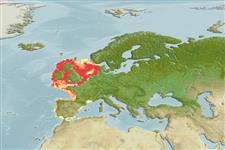Environment: milieu / climate zone / distribuzione batimetrica / distribution range
Ecologia
marino; salmastro demersale; non migratori; distribuzione batimetrica 0 - 110 m (Ref. 35388). Temperate; 60°N - 35°N, 11°W - 8°E
Northeast Atlantic: southern North Sea, Irish Sea, and southwestern Ireland to Portugal. Mediterranean Sea: Málaga, Spain.
Size / Peso / Age
Maturità: Lm ? range ? - ? cm
Max length : 18.5 cm TL maschio/sesso non determinato; (Ref. 106276)
Spine dorsali (totale) : 4; Raggi dorsali molli (totale) : 10; Raggi anali molli: 8 - 10. Preopercular spine present. Antrorse (forward-pointing) spine at base very small, rudimentary or absent. Second dorsal in males with dark blotches in vertical or oblique rows, in females colorless (Ref. 232). Gill cover with 3 spines. Snout slightly longer than the eye diameter (Ref. 35388).
Body shape (shape guide): elongated.
Occurs in inshore waters, even intertidally, on sandy shores (Ref. 6444).
Eggs and larvae pelagic (Ref. 5968).
Bauchot, M.-L., 1987. Poissons osseux. p. 891-1421. In W. Fischer, M.L. Bauchot and M. Schneider (eds.) Fiches FAO d'identification pour les besoins de la pêche. (rev. 1). Méditerranée et mer Noire. Zone de pêche 37. Vol. II. Commission des Communautés Européennes and FAO, Rome. (Ref. 3397)
IUCN Red List Status (Ref. 130435: Version 2025-1)
Threat to humans
Harmless
Human uses
Pesca: di nessun interesse
Strumenti
Special reports
Download XML
Fonti Internet
Estimates based on models
Preferred temperature (Fonte Biblio.
123201): 7.7 - 12.5, mean 10.5 °C (based on 484 cells).
Phylogenetic diversity index (Fonte Biblio.
82804): PD
50 = 0.5000 [Uniqueness, from 0.5 = low to 2.0 = high].
Bayesian length-weight: a=0.00759 (0.00555 - 0.01037), b=2.73 (2.68 - 2.78), in cm total length, based on LWR estimates for this species (Ref.
93245).
Trophic level (Fonte Biblio.
69278): 3.3 ±0.39 se; based on food items.
Resilienza (Fonte Biblio.
120179): Medio, tempo minimo di raddoppiamento della popolazione 1.4 - 4.4 anni (Preliminary K or Fecundity.).
Fishing Vulnerability (Ref.
59153): Low vulnerability (10 of 100).
🛈
